If strict criteria are set, the Smith & Wessons 40 cartridges would be the only significant new short weapon calibre since 1951, the year in which the Russian PM pistol in 9 mm Makarow was introduced. All the other newly introduced calibres are niche products.
Viewed internationally, they can reach the success of .40 S & W to some extent with respect to their spread. But what makes this calibre so special?
The success formula simply lies in its large, thick and heavy calibre based on the current state of technology used for manufacturing pistols and ammunition and the fact that it can be used with small glove sizes and low level of training with a high magazine capacity.
Price could certainly not be a reason for it. Just like in Germany, .40 S & W is clearly more expensive than the ammunition in 9 mm Luger overseas as well. Simple training ammunition in .40 S & W is, however, cheaper than in .45 ACP at least in USA. This has not been the case until now in this part of the world however.
Fear of failure
There are neither any myths nor legends on the history of .40 S & W. On the contrary, its emergence is well documented and begins in Miami.
In 1986, the Miami Shootout took the life of the FBI agent Jerry Dove and Ben Grogan, with five other agents getting severely injured in the shooting encounter with two serious criminals. Later, minute details of the incident were studied in order to eradicate any weaknesses in equipment, strategy and training.
In the area of equipment, the merciless eye of FBI fell on the combination of the 9 mm pistol S & W M459 with the matching silvertip hollow point ammunition of Winchester. In the encounter that lasted for a few minutes, one of these bullets struck on the upper arm of the gangster Michael Platt but subsequently remained stuck in his chest without injuring the heart.
This had some bad consequences: Platt managed to injure three federal police officers and kill two others despite having a collapsed right lung lobe and some other serious injuries.
Something new was required:
At that time, FBI was equipped with revolvers to some extent as well (even in Miami) and the brand “Wonder Nines” would have failed at least in this extreme case.
Now the eye of the US federal police fell on the cartridge 10 mm Auto. For this, there were only two weapon types M 1911 A1 and the equally large (and heavy) Double Action Pistol M 1006 of S & W. The 10 mm Auto cartridge in its original form had a great performance, however, even before being muzzled. The strong cartridge unnecessarily put strong pressure on the weapon as well as the shooter.
Subsequently, the model 1076 of Smith & Wesson was introduced which was a somewhat smaller all-steel variant of 1006.
The suitable ammunition for it was manufactured by Federal, a 10 mm Auto “Lite” with bullet weight of 180 grains (grs) and muzzle energy of around 500 Joule (J).
FBI was satisfied with the ballistic performance at that time but not with the heavy M 1076 with its eight-bullet magazine. The fact that everything was even easier to handle with a similar external ballistics concept was shown almost at the same time by Smith & Wesson in cooperation with Winchester.
The .40 S & W introduced in 1990 had almost the same performance as the 10 mm Auto of FBI. However, it could even be stacked in a magazine in a two-row design at a gas pressure comparable with a 9 mm luger (alias 9 mm parabellum, metric: 9 x 19 mm) even in a much shorter 21 mm shell which allowed the use with classical 9 mm handgrips.
For both companies, .40 S & W was a big success.
With M 4006, the first pistol from Springfield in .40 S & W, one could offer a weapon with a magazine capacity of eleven instead of a meagre eight cartridges with similar dimensions and performance parameters to that of M 1076.
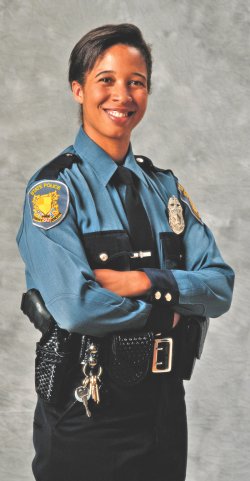
Ironically, Glock managed to take over the US company in 1990 with the model 22 however and to fill the American retailer shelves with the 40 weapons some months before the competition. The choice of FBI did not remain unnoticed by other judicial and police authorities.
Even the large police departments may not have the opportunity (or free financial resources) to carry out the lengthy tests for the selection of the best possible equipment with weapons and ammunitions especially when the equipment was still not ready for series production and freely available in the law enforcement market.
The selection of weapons:
Today, it is difficult to find a renowned pistol manufacturer who offers models in the 0 mm para but not .40 calibres at the same time. Some small 1911 manufacturers were well known in this area but that was all.
Be it renowned armament companies such as Heckler & Koch or low-cost suppliers such as Hi-Point Firearms, anyone who wants to mix into the US market cannot avoid calibres.
In the initial years, it was quite different. Most of the manufacturers first of all tried to adjust their well-proven 9 mm designs for the .40 S & W model. Sometimes, this yielded success from the very beginning.
The old S & W M 400 made of stainless steel is basically nothing different from a 10 mm version of the M 5906 in 9 mm luger, the ancestral line of which dates back to the 70s – admittedly still with Dural frames at that time.
The California Highway Patrol purchased the M 4006 model in as early as 1990 and was so satisfied with the pistol that it ordered it again 17 years later, this time however with an in-milled Picatinny mounting rail in the frame for tactical flashlights.
The Glock 22 advanced to become the most common pistol model among US police officers in a very short time.
Other companies enjoyed less luck with the simple “drilling out” of their Nine Paras.
FABRIQUE NATIONAL spendierte der High Power zunächst ein stabileres (gegossenes) Stahlgriffstück und verstärkte dann noch den Schlitten. Heute verkauft die FABRIQUE NATIONALE trotzdem lieber Polymerpistolen, auch in .40 S & W.
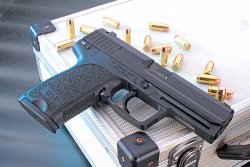
Heckler & Koch manufactured the heavy P7 M10 model which is a desirable collectible item today among the more modern short weapons. The succeeding service pistol USP was designed from the beginning for .40 S & W however.
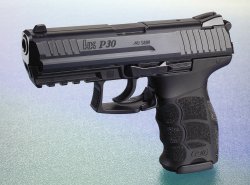
The last model in the H & K family is the P30. Since 3 years the P30 is available in 40S&W (below you can see the test results). The P30 in 40S&W has a capacity of 13 rounds and the same modular frame like the other P30 models.
SIG-Sauer did not make any effort to design the completely stable slide till that time for the new cartridge as well – all the 40 SIG-SAUER had receiver casing milled from solid metal on the spot.
Beretta M 96 was not a flop as a service weapon but could never enjoy the success of the famous sibling M 92 and is not considered to be as robust and durable in .40 as in 9 mm Luger.
Made in USA
In the public sector, .40 S & W forced back the “Wonder Nines” during the last 20 years.
FBI uses the 40 Glock pistols on a regular basis today and the standard weapon is the compact Glock 3. United States Marshal Service uses the Glock 22.
Many police officers at the communal level have pistols (40) of different manufacturers, mostly of Glock, SIG-Sauer, Beretta or even Heckler & Koch.
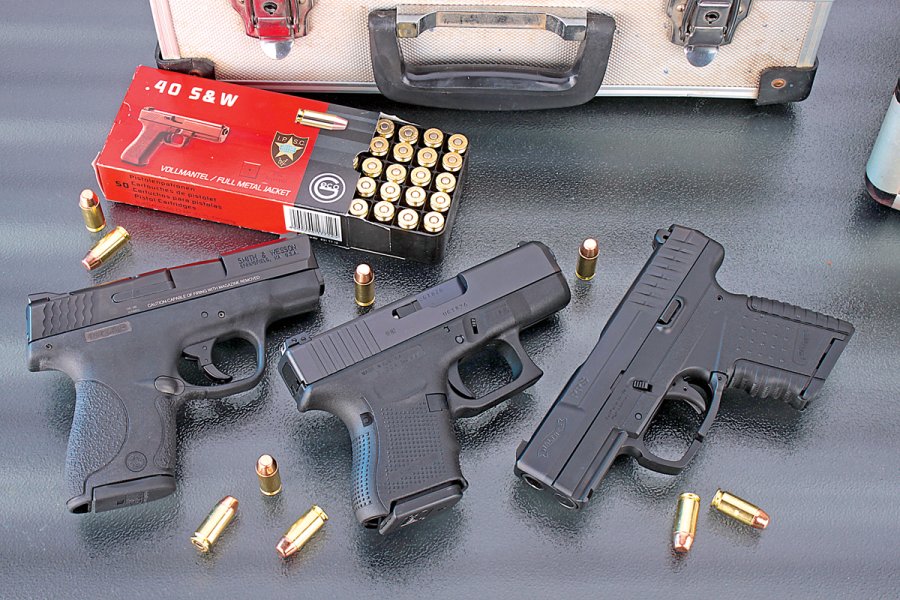
In the new police units of the federal states, latest calibres have replaced the Wonder Nine almost completely during the last 20 years. In the State Troopers of Indiana and New Jersey, the Nine Para still go on patrol but that is all.
Six states currently use the old .45 ACP. And quite interestingly, five federal states have equipped their police officers with Glocks in .45 G.A.P model. In Germany, there are assumedly more pistols in the .50 Action Express model than in .45 G.A.P.
Eleven state authorities use the .357 SIG. The other federal states give preference to .40 S & W: over one half of the 50 US federal states.
The popularity of the .40 S & W and the downfall especially of 9 x 19 mm in USA can be explained by the fact that the law enforcement ammunition in .40 and other large calibres had yielded better results, at least a few years ago, with respect to their effectiveness in firing and penetrating through covers such as vehicle bodies, screens and the like.
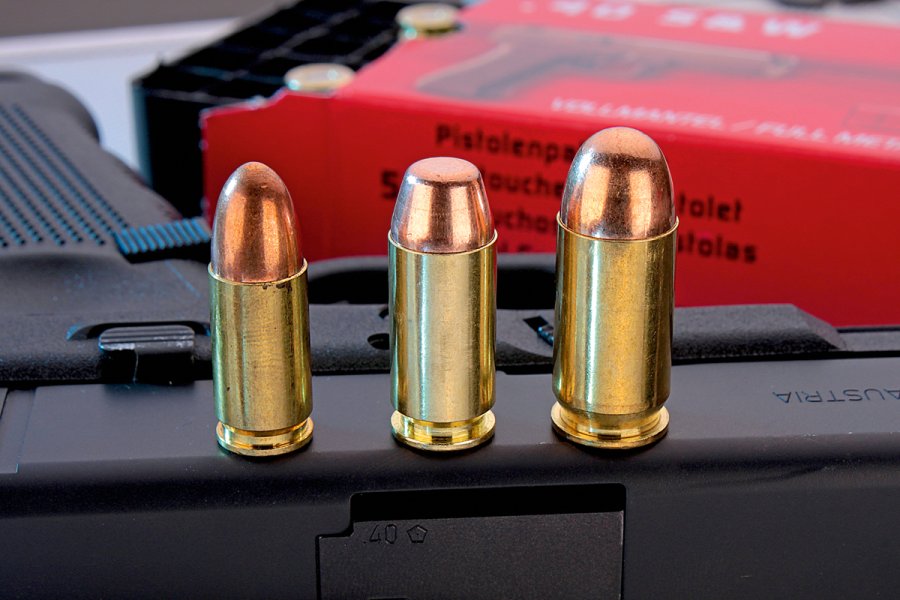
The new bonded hollowpoints like SPEER GOLD DOT and others improved the perfomance of the 40S&W. Especial the perfomance behind a barrier seems to be much better.
Latest developments in the US ammunition sector have apparently cleared out however- the superior “barrier blindness” of .40 S & W is no longer a topic today.
The Premium-Hollow Points of US-manufacturers such as Speer, Federal, Winchesteror Remington are designed independent of the calibre such that the ballistic gelatine covered with several layers of denim fabric can expand uniformly and a penetration of around 25 to 30 centimetres is achieved.
At a similarly high gas pressure, a .40 S & W carries along a larger and (mostly) more heavy bullet as a Nine Para which expands on a large scale as well and hence has more chance of destroying the tissue. An additional ten to 15 percent of muzzle energy is present in this case. The 10 x 21 mm shell of the 40 cartridge simply provides more capacity than the brass of Nine Para filling.
From German view
On the law enforcement market, the cartridge hardly plays a role.
The federal police, customs, police force of the federal states, the German armed forces – all use them since more than 40 years on a large scale with the 9 mm Luger.
In the civil sector, it certainly looks better for the US development.
Among huntsmen as well as sport shooters, the .40 S & W model has made its way although in popularity, it may lie clearly behind the 9 mm parabellum or .45 ACP.
An important reason for the growing popularity not only lies in the ballistic quality of the 10 mm calibre alone but also in the characteristics of the German weapons law. If one has bought a pistol, it allows for purchase of further interchangeable barrels or systems without requiring another
needs test and these can be used with the same grip.
The calibre must always be smaller or of the same size as that of the initially purchased weapon. One can easily find an interchangeable system in 9 mm Luger or .22 Lr. for a 40 CZ-75. However, a 9 mm pistol cannot be supplemented so easily with another top part in .40 S & W.
This regulation does not seem to make any sense. It holds back the legal possessor of the weapon and does not bring about any additional protection from misuse of weapons.
If the calibres such as .357 SIG, .40 S & W or .45 ACP had more advantages than disadvantages from point of view of the German executive authority, one would at least have tried and perhaps bought them by the time of the last generation change in pistols and ammunition. This did not occur however.
As always: Whoever purchases a weapon in .40 S & W model today has more options to buy uncomplicated interchangeable systems or barrels than those who decides to purchase a smaller calibre such as the 9 x 19 mm.
As a hunting companion, the cartridge does not leave a bad look. The recoil remains well controllable in small thin pistols such as Kahr or Walther PPs.
The muzzle flip is certainly stronger here than in case of a 9 mm Luger with similar performance. However, in full-fledged service pistols, the disturbing effect on the possible temp of the shooting is note noticed by everyone. In small sub-compact models, the hand would sense this however.
Calibre .40 S & W in sports shooting:
IPSC
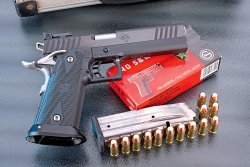
The classical field of application for .40 S & W worldwide is the standard class of IPSC (International Practical Shooting Confederation). Here, the.40 S & W is the smallest pistol calibre permitted which can be evaluated as “Major” with regard to the shooting accuracy, provided that the ammunition achieves a power factor of 165. This is managed by the cartridge without any problem with heavy bullets:
Usually, fabric filling beyond 170 grs is designed for it at least to exceed the IPSC major factor from a 114 mm barrel of a Glock 22.
The good old .45 ACP can also achieve this but so many cartridges cannot fit into the magazine. And the unnecessary re-loading times are not accepted by any committed shooter without a good cause.
One can definitely shoot smaller calibres such as the 9 mm Luger as well in the standard class and have a few more shots remaining in the magazine. However, every shot would then be evaluated as “Minor”: Shots in the edge zones of the screens bring fewer points.
In USA, it is not uncommon to step up in the Production Division with a .40 S&W. Since changes in regulations, the magazine capacity is restricted to a maximum of 15 cartridges and hence many full-fledged service models in .40 S & W can keep up with the small Nine Para even in terms of the ammunition level.
The unnecessarily strong power factor of the .40 S & W remains with strong recoil. On the contrary, the development of matching “Lite” helps- loading by hand, mostly coupled with the change to a weaker closing spring.
Together with around 3.5 to 4 grs of fast pistol propellant, a bullet weight of around 180 grs provides a relatively suitable round of ammunition with a power factor of 130 for shooting competitions. Most of the powder manufacturers also publish the suitable formulas for reloaders.
A “40 Lite” does not offer any direct advantages in contrast to special loading in 9 mm Luger for exceeding the minor factor of 125. However, one can see the larger holes in the screen in a slightly better way.
For many US sport shooters, the advantage of larger calibres lies in the streamlined logistics including the quantity discounts.
USPSA Production, the standard class IDPA, self-defence – all is done with the .40 S & W. And therefore, ammunition or reloading components only have to be purchased for this.
Costs and benefits:
Apart from the standard class IPSC the purchase of a weapon in .40 S & W is not always worth it.
In case of simple training ammunition of good quality, one has to pay around 100 euro more for all thousand fabric cartridges than for similar Nine Para.
A couple of centre can be saved per bullet in case of a 40 pistol if one keeps the fired brass shells.
Unmixed shells which have only been fired once from a batch can bring about more when sold than the more commonly used shells in 9 mm Luger.
Despite this: If the ammunition costs are going to spoil the training for someone, the 9 x 19 mm which cost about one third less would be the better alternative.
Especially for BDS shooters, there are some interesting options in contrast to the other sport associations in the lower and middle pistol price segments during weapon selection.
Even without being able to compete with a Les Baer or P 210, the modern service weapons are quite precise for shooting competitions. They usually require only an adjustable notch as well as moderate trigger tuning. After this, the coxswain decides more about the placement than the equipment.
Suitable interchangeable systems are quite often comparatively cheaper to purchase, can be replaced quickly and without requiring any tools and do not have to be adjusted additionally by a technical expert. In this way, several disciplines are quickly covered without wasting a valuable WBK entry.
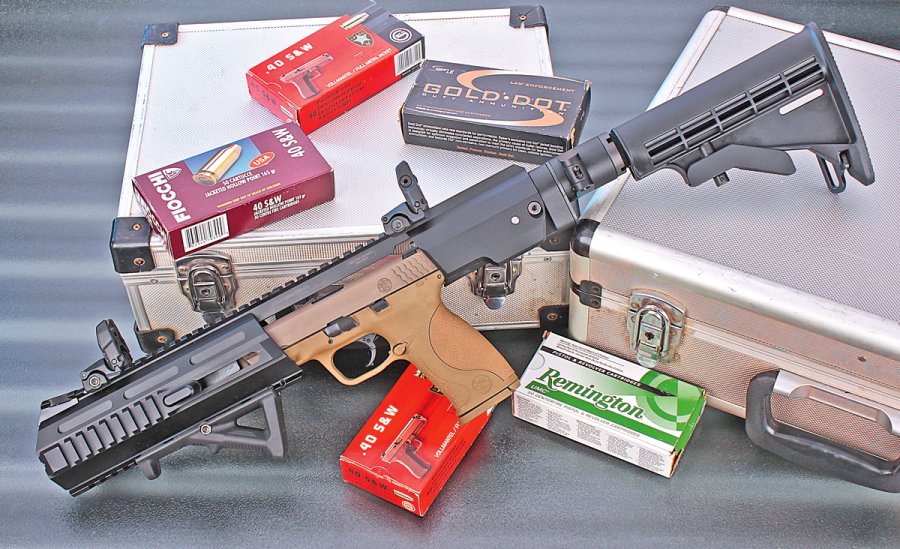
Even for a huntsmen, 40 S & W carries an advantage:
One can also use the ammunition which is suitable for hunting with the 40 Golder Saber of Remington or the Federal Tactical Bonded and this is considered to be reliable and effective by the US authorities.
Some pistols in .40 Smith & Wesson:
| Modell | Smith & Wesson M & P Shield | Smith & Wesson M & P 40L Pro Series | Smith & Wesson M & P 40 VTAC | Walther PPS .40 | Heckler & Koch USP |
| Price: | 762 Euro | 889 Euro | 1018 Euro | 719 Euro | 849 Euro |
| Capacity: | 6 (7) + 1 Patronen | 15 + 1 Patronen | 15 + 1 Patronen | 5 (6) + 1 Patronen | 14 + 1 Patronen |
| Measurements mm(LxWxH): | 155 x 27 x 118 mm | 213 x 33 x 140 mm | 193 x 33 x 140 mm | 159 x 26 x 111 mm | 196 x 36 x 137 mm |
| Barrel: | 79 mm | 125 mm | 106 mm | 80 mm | 108 mm |
| Sight Length: | 134 mm | 184 mm | 162 mm | 131 mm | 156 mm |
| Rear Sight: | 3,6 mm, White Dot | 3,6 mm, Novak | 3,6 mm, VTAC | 4,6 mm, White Dot | 4,2 mm |
| Front Sight Post: | 3,5 mm, White Dot | 3,4 mm, Lichtsammmler | 2,9 mm, VTAC | 3,6 mm, White Dot | 3,5 mm |
| Trigger Pull: | 3100 g | 2100 g | 2900 g | 2450 g | 2300 / 5120 g |
| Weight: | 575 g | 820 g | 795 g | 600 g | 832 g |
HECKLER & KOCH P 30, .40 S & W
| No. | Ammunition | SK (mm) | v2 (m/s) | Es (J) |
| 1) | 155 grs Hornady TAP FPD | 72 | 337 | 570 |
| 2) | 160 grs Magtech L-SWC | 71 | 327 | 554 |
| 3) | 165 grs American Eagle FMJ | 58 | 336 | 604 |
| 4) | 165 grs Speer Gold Dot JHP | 67 | 329 | 579 |
| 5) | 170 grs GECO FMJ | 74 | 318 | 557 |
| 6) | 170 grs Leader FMJ | 91 | 284 | 444 |
| 7) | 180 grs Hornady Steel Match HAP | 42 | 289 | 487 |
| 8) | 180 grs Federal Tactical Bonded JHP | 52 | 296 | 511 |
| 9) | 180 grs Magtech Guardian Gold JHP | 93 | 278 | 451 |
| 10) | 180 grs Magtech FMJ-Flat | 91 | 318 | 590 |
| 11) | 180 grs Remington Golden Saber JHP | 67 | 301 | 528 |
| 12) | 180 grs Sellier & Bellot FMJ | 76 | 290 | 490 |
| 13) | 180 grs Winchester FMJ | 77 | 285 | 474 |
Annotations: SK (mm): Five-Shot-Groups, 25 m Range
Shortcuts: V2 (m / s): Bullet velocity, two Meters from the muzzle.
E2 (J): Energie in Joules
Acronyms: JHP: Jacketed Hollow Point (Mantel-Hohl-spitz); FMJ: Full Metal Jacket; L-SWC: Lead-Semiwadcutter; HAP: Hornady Action Pistol; TAP: Tactical Application Police; FDP: For Personal Defense
Smith & Wesson M & P 40 VTAC, .40 S & W
| No. | Ammunition | SK (mm) |
| 1) | 165 American Eagle FMJ | 91 |
| 2) | 165 grs Speer Gold Dot JHP | 115 |
| 3) | 170 grs GECO FMJ | 104 |
| 4) | 170 grs Leader FMJ | 82 |
| 5) | 180 grs Hornady Steel Match HAP | 103 |
| 6) | 180 grs Magtech FMJ-Flat | 127 |
Annotations: SK (mm): Five-Shot-Groups, 25 m Range
Acronyms: JHP: Jacketed Hollow Point ; FMJ: Full Metal Jacket
Walther PPS, .40 S & W
| No. | Laborierung | SK (mm) |
| 1) | 165 grs American Eagle FMJ | 110 |
| 2) | 165 grs Speer Gold Dot JHP | 101 |
| 3) | 170 grs GECO FMJ | 153 |
| 4) | 180 grs Sellier & Bellot | 108 |
| 5) | 180 grs CCI Blazer Brass | 107 |
| 6) | 180 grs Magtech FMJ - Flat | 126 |
Annotations: SK (mm): Five-Shot-Groups, 25 m Range
Acronyms: JHP: Jacketed Hollow Point; FMJ: Full Metal Jacket


